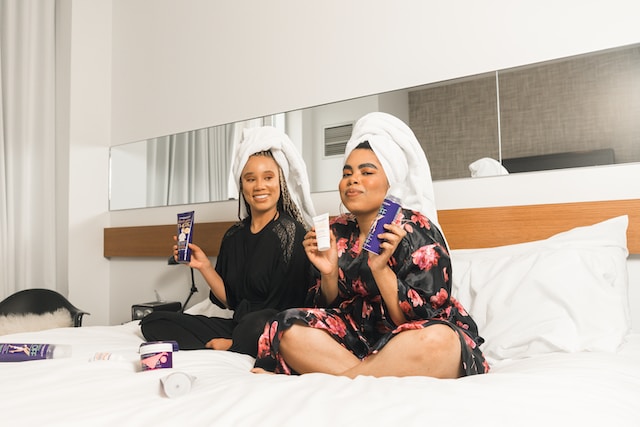
Moisturizer vs Serum: Which is Best For Anti-Aging?
Skincare plays a crucial role in the battle against aging. As we strive to maintain a youthful and vibrant appearance, it’s important to understand the benefits and differences between moisturizers and serums.
These two skincare products, while sharing the common goal of promoting healthy skin, have distinct characteristics and functionalities that cater to specific needs.
In this Blog, we will delve into the world of moisturizers and serums, exploring their unique properties and discussing which one is best for anti-aging purposes.
I. The importance of skin care in anti-aging
Before diving into the specifics of moisturizers and serums, it’s crucial to highlight the significance of skincare in the context of anti-aging. Our skin is exposed to various environmental factors, such as pollution, UV radiation, and free radicals, which can accelerate the aging process.
By implementing a diligent skincare routine, we can combat these external aggressors and promote skin health, ultimately slowing down the signs of aging.
II. Understanding Moisturizers
A. What are moisturizers?
Moisturizers are skincare products designed to hydrate and nourish the skin. They work by replenishing the skin’s moisture barrier, preventing water loss, and improving overall skin health.
A well-formulated moisturizer contains a combination of humectants, emollients, and occlusives that work together to lock in moisture, leaving the skin soft, supple, and plump.
B. How do moisturizers work on the skin?
When applied to the skin, moisturizers form a protective layer that seals in moisture, preventing evaporation.
Humectants, such as hyaluronic acid and glycerin, attract water from the environment and bind it to the skin, providing immediate hydration.
Emollients, like plant oils and butter, help smooth the skin’s surface and improve its texture.
Occlusives, such as petrolatum and dimethicone, create a barrier that reduces water loss and protects the skin from external irritants.
C. Different types of moisturizers
1. Creams
Creams have a thick and luxurious texture, making them ideal for individuals with dry or dehydrated skin. They provide intense hydration and create a protective barrier on the skin’s surface.
Cream-based moisturizers often contain nourishing ingredients like shea butter, jojoba oil, or ceramides, which help replenish the skin’s moisture levels and restore its natural balance.
2. Lotions
Lotions have a lighter consistency compared to creams, making them suitable for normal to combination skin types. They are easily absorbed and provide a balanced level of hydration without feeling heavy or greasy.
Lotions often contain a blend of water, oils, and emulsifiers, delivering moisture to the skin while maintaining a lightweight feel.
3. Gels
Gels are refreshing and lightweight moisturizers, typically recommended for oily or acne-prone skin. They have a gel-like consistency that quickly absorbs into the skin, leaving behind a cool and non-greasy finish.
Gel-based moisturizers are formulated with water-based ingredients, hyaluronic acid, and aloe vera, providing hydration without clogging pores.
D. Key ingredients in moisturizers
1, Hyaluronic acid
Hyaluronic acid is a powerhouse ingredient in moisturizers, known for its ability to attract and retain moisture. It has the remarkable capacity to hold up to 1,000 times its weight in water, resulting in intense hydration and a plumping effect on the skin.
By incorporating hyaluronic acid into moisturizers, the skin’s moisture levels are replenished, fine lines are minimized, and the complexion appears more youthful.
2. Glycerin
Glycerin is a humectant widely used in moisturizers due to its excellent water-attracting properties. It draws moisture from the environment and binds it to the skin, ensuring continuous hydration.
Glycerin also strengthens the skin’s natural barrier, protecting it from external aggressors and improving its resilience.
3. Ceramides
Ceramides are naturally occurring lipids found in the skin’s outermost layer, responsible for maintaining its integrity and moisture balance.
In moisturizers, synthetic ceramides are often used to replenish the skin’s ceramide levels, reinforcing the skin barrier, and preventing moisture loss.
By restoring the skin’s lipid barrier, moisturizers with ceramides help to improve the skin’s overall hydration and protect it from environmental stressors.
III. Exploring Serums
A. What are serums?
Serums are lightweight and highly concentrated skincare products that deliver active ingredients deep into the skin. Unlike moisturizers, which primarily focus on hydration, serums target specific skin concerns such as aging, dullness, or hyperpigmentation.
Due to their potent formulations, serums are often considered a powerful addition to any skincare routine.
B. How do serums differ from moisturizers?
The main difference between serums and moisturizers lies in their formulation and functionality. While moisturizers primarily focus on providing hydration and maintaining the skin’s moisture levels, serums are formulated to penetrate deeply into the skin, delivering a high concentration of active ingredients.
Serums have a lightweight consistency that allows for better absorption and effectiveness.
C. Benefits of serums in anti-aging
Serums are particularly beneficial in the fight against aging due to their concentrated and targeted formulations. They often contain potent ingredients such as retinol, vitamin C, and peptides, which address specific concerns like fine lines, wrinkles, and uneven skin tone.
By incorporating serums into your skincare routine, you can effectively target signs of aging and achieve visible improvements in your skin’s texture and appearance.
D. Types of serums
1. Hydrating serums
Hydrating serums focus on replenishing and retaining moisture in the skin. They typically contain ingredients like hyaluronic acid, glycerin, or ceramides, which provide intense hydration and plumpness.
Hydrating serums are suitable for all skin types and can be used as a standalone treatment or in conjunction with a moisturizer.
2. Brightening serums
Brightening serums are designed to address issues such as dullness, uneven skin tone, and dark spots. They often contain ingredients like vitamin C, niacinamide, or licorice extract, which help to lighten hyperpigmentation and promote a more radiant complexion.
Brightening serums are especially beneficial for individuals looking to achieve a more luminous and even skin tone.
3. Anti-aging serums
Anti-aging serums target multiple signs of aging, including fine lines, wrinkles, and loss of elasticity. They typically contain powerful ingredients such as retinol, peptides, or antioxidants, which stimulate collagen production, firm the skin, and reduce the appearance of wrinkles.
Anti-aging serums are ideal for individuals who want to address specific age-related concerns and achieve a more youthful complexion.
IV. Key Differences Between Moisturizers and Serums
While both moisturizers and serums play vital roles in skincare, there are key differences that set them apart. Understanding these differences can help individuals make informed choices based on their specific needs and desired outcomes.
A. Texture and consistency
Moisturizers tend to have thicker and richer textures, designed to provide hydration and create a protective barrier on the skin’s surface.
Serums, on the other hand, have lightweight and fluid consistencies that allow for better absorption and deeper penetration of active ingredients.
B. Penetration into the skin
Moisturizers primarily work on the skin’s surface, forming a barrier to lock in moisture and protect the skin from external factors.
Serums, with their lightweight formulations, penetrate deeper into the skin, delivering a high concentration of active ingredients directly to the targeted areas.
C. Active ingredient concentration
Moisturizers contain a blend of active ingredients, but their concentration is generally lower compared to serums.
Serums are formulated with higher concentrations of potent ingredients, allowing for more targeted and noticeable results when addressing specific skin concerns.
D. Targeted benefits
Moisturizers focus on providing hydration, nourishment, and protection to the skin. They help maintain the skin’s moisture balance, promote a smooth texture, and support overall skin health.
Serums, on the other hand, are formulated to target specific concerns such as aging, hyperpigmentation, or dullness, providing more specialized treatment and visible improvements.
V. Moisturizer vs Serum: Which is Best for Anti-Aging?
When deciding between a moisturizer and a serum for anti-aging purposes, several factors should be taken into consideration.
A. Factors to consider when choosing between moisturizer and serum
1. Skin type and concerns
Understanding your skin type and specific concerns is essential in determining which product will be most beneficial for you.
Dry or dehydrated skin may benefit from a moisturizer’s hydrating properties, while individuals with specific aging concerns may find serums with targeted ingredients more suitable.
2. Desired results
Consider the specific results you wish to achieve. If your primary goal is to maintain overall skin hydration and protection, a moisturizer may be sufficient.
However, if you’re looking to address fine lines, wrinkles, or hyperpigmentation, a serum with potent active ingredients may deliver more visible results.
3. Personal preferences
Consider your personal preferences in terms of texture, application, and skincare routine. Some individuals prefer the luxurious feel of a cream moisturizer, while others enjoy the lightweight and fast-absorbing nature of serums.
Personal preferences can significantly influence your choice between moisturizers and serums.
B. Anti-aging benefits of moisturizers
1. Hydration and plumping effects
Moisturizers excel in providing immediate and long-lasting hydration to the skin. They replenish moisture levels, restore the skin’s natural barrier, and promote a plump and healthy complexion. Well-hydrated skin appears smoother, firmer, and more youthful.
2. Protection against environmental stressors
Moisturizers create a barrier on the skin’s surface, shielding it from environmental stressors such as pollution, UV radiation, and harsh weather conditions.
Moisturizers help prevent premature aging caused by environmental factors by protecting the skin.
3. Reduction of fine lines and wrinkles
Although moisturizers may not have the same concentrated active ingredients as serums, they can still contribute to the reduction of fine lines and wrinkles. Through consistent use, moisturizers promote overall skin health, improve elasticity, and minimize the appearance of fine lines over time.
C. Anti-aging benefits of serums
1. Higher concentration of active ingredients
One of the key advantages of serums is their high concentration of active ingredients. This allows for more potent and targeted treatment of specific skin concerns, such as fine lines, wrinkles, or hyperpigmentation. Serums can deliver noticeable improvements and visible results when used consistently.
2. Targeted treatment for specific concerns
Serums are formulated to address specific skin concerns, making them highly effective in targeting aging-related issues. Whether you’re looking to improve skin texture, fade dark spots, or boost collagen production, serums provide specialized treatment and can deliver significant improvements in targeted areas.
3. Enhanced absorption and effectiveness
Due to their lightweight formulations, serums are easily absorbed into the skin, allowing active ingredients to penetrate deeply and work more effectively. The concentrated nature of serums ensures that the skin receives a potent dose of beneficial ingredients, maximizing their anti-aging benefits.
VI. Expert Recommendations
A. Dermatologist advice on choosing the right product
- Consult a dermatologist or skincare professional to assess your skin type, concerns, and specific needs.
- Consider products with clinically proven ingredients that target your specific anti-aging concerns.
- Look for moisturizers and serums that are non-comedogenic, hypoallergenic, and fragrance-free to minimize the risk of irritation or adverse reactions.
- Opt for products that are backed by scientific research and have a reputable brand history.
B. Combination approach: Using both moisturizer and serum
- Incorporating both moisturizer and serum into your skincare routine can provide comprehensive benefits.
- Start with a lightweight serum that targets your specific concerns, allowing it to penetrate the skin.
- Follow up with a moisturizer to lock in hydration, provide a protective barrier, and further nourish the skin.
- Layering products can enhance their effectiveness, but be mindful not to overload the skin with too many active ingredients.
VII. Tips for Maximizing Results
To maximize the results of your anti-aging skincare routine, consider the following tips:
A. Proper skincare routine
Follow a consistent skincare routine that includes cleansing, toning, applying serums and moisturizers, and protecting your skin with sunscreen. Consistency is key to achieving long-term results.
B. Application techniques for moisturizers and serums
Apply moisturizers and serums using gentle upward motions, ensuring even distribution and absorption into the skin. Avoid tugging or rubbing excessively, as it can lead to skin irritation.
C. Layering with other skincare products
Consider incorporating other beneficial skincare products into your routine, such as sunscreen, exfoliants, or masks. Layering these products strategically can enhance their efficacy and provide comprehensive anti-aging benefits.
VIII. Understanding Your Skin’s Needs
Understanding your skin type and assessing your specific anti-aging concerns is crucial in selecting the right products for your skincare routine. Consult with a dermatologist or skincare professional to determine your skin type and identify any specific issues that require attention.
IX. Common Ingredients to Look for in Anti-Aging Products
When choosing anti-aging products, keep an eye out for key ingredients that have been proven effective in addressing signs of aging:
A. Retinol
Retinol, a derivative of vitamin A, is a powerhouse ingredient in anti-aging skincare. It promotes cell turnover, stimulates collagen production, and helps reduce the appearance of wrinkles and fine lines.
B. Vitamin C
Vitamin C is a potent antioxidant that brightens the skin, evens out skin tone, and stimulates collagen synthesis. It also protects the skin from free radical damage, reducing the signs of aging.
C. Peptides
Peptides are amino acid chains that help improve skin elasticity, promote collagen production, and reduce the appearance of wrinkles. They are effective in addressing various signs of aging and supporting overall skin health.
D. Antioxidants
Antioxidants such as green tea extract, resveratrol, or niacinamide protect the skin from environmental damage, reduce inflammation, and help maintain a youthful complexion.
X. Potential Side Effects and Precautions
While moisturizers and serums are generally safe for use, it’s essential to be aware of potential side effects and take the necessary precautions:
A. Allergic reactions
Individuals with sensitive skin may experience allergic reactions to certain ingredients. It’s advisable to perform a patch test before incorporating a new product into your routine and to discontinue use if any adverse reactions occur.
B. Sensitivity to certain ingredients
Some individuals may be sensitive to specific ingredients commonly found in skincare products. It’s important to read ingredient labels carefully and avoid products that contain ingredients known to cause irritation or sensitivity.
C. Patch testing
Patch testing involves applying a small amount of the product to a small area of skin, typically behind the ear or on the inner forearm, to check for any adverse reactions. This step is particularly important when introducing new products or ingredients into your skincare routine.
Conclusion
In the quest for youthful and healthy-looking skin, understanding the difference between moisturizers and serums is crucial. While both play important roles in skincare, they offer distinct benefits when it comes to anti-aging.
Moisturizers act as a barrier, shielding the skin from external stressors and maintaining its moisture balance.
On the other hand, serums penetrate deep into the skin, delivering visible results in addressing aging-related issues such as fine lines, hyperpigmentation, and dullness.
The key to making the right choice lies in understanding your specific skin type, concerns, and desired results. It is advisable to consult with skincare experts and dermatologists to create a personalized skincare routine.
Remember, each individual’s skincare journey is unique, and what works for one may not work for another. Consistency is key, so make sure to use retinol and vitamin C, as well as to take good care of your skin in the sun.
By finding the right balance of moisturizers and serums, you can embark on a skincare journey tailored to your needs, assisting you in achieving your anti-aging goals and maintaining a healthy, luminous complexion.


You May Also Like

How to Get Rid of Dark Circles: Effective Tips and Products
31 December 2023
10 Ways To Wash Your Face
30 July 2024

